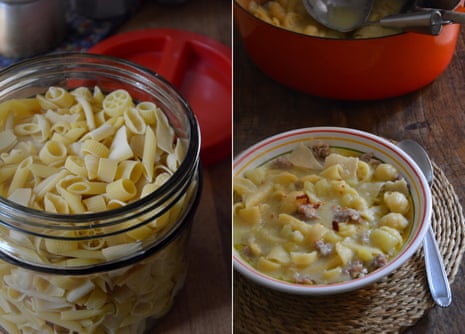A consequence of writing a book about pasta is a cupboard filled with shapes. While I try to keep it under control, taking almost weekly inventories of the tubes, wheels, horses’ teeth, devils, stars, penises and spaghetti in my head-height cupboard, it quickly reverts to a game of Tetris: many open packets, many of them ready to fall. Another consequence is that I have plenty of questions for packet designers about closure, seals, paper perforation and the apparently adjustable sticker that so often isn’t. Not that I depend on stickers any more: plastic clothes pegs are my preferred way to close packets that are not going into the jar.
The pasta mista jar, which is short and tubby with a red, twist-on lid, is home to the ends of packets. While it is surely common anywhere there is pasta and a resourceful cook, pasta mista seems synonymous with Naples, where they call it pasta ammiscata or ammescata. The writer Annalisa Barbagli describes how, as recently as 50 years ago, pasta was sold loose in grocery stores, scooped from large, deep drawers with glass fronts. The remains at the bottom of these drawers, the leftovers and fragments, corners and broken bits, were all swept together. Pasta ammiscata was then given its own drawer and sold cheaply: the Neapolitan equivalent of Woolworths’ broken biscuits.
Pasta mista was also assembled at home, ends rounded up like unruly children and put in one place. You want to keep an eye on the various shapes you are tipping into the jar, making sure that cooking times are similar. At the same time, the differences are part of its beauty: the twists slightly firmer than the rombo (rhombus), the almost crunchy, ruffle-edged mafaldine, which makes for a nice contrast to a soft soup.
The home for pasta mista is in minestre, the extended family of soups made from vegetables, maybe a little meat and often beans, which are bolstered and further thickened with pasta and the amido (starch) that seeps from it as it cooks. Pasta mista is also the shape for any of the numerous versions of pasta e patate (pasta and potatoes). I have written about this dish twice before, which is testament to how much I like and depend on it, week in, week out. This week’s version begins as the others do, by frying aromatic vegetables in oil, then adding cubed potatoes, a bay leaf and water. The difference comes in the next steps: this is for anyone who has ever told me that a recipe would be better with meat in it, and the friend whose motto is “put a sausage in it or on it”.
Like most minestra and thick soups, especially those that include pasta, this dish benefits from a rest before you eat it. Let it sit for 10 minutes or thereabouts, so it is “nè bollente, nè fredda” (neither hot nor cold), but rather somewhere in the middle, which best suits both the flavour and texture: the collapsing potato, rich crumble of sausage, various degrees of pasta and fusing cheese, and you.
Pasta e patate con salsiccia (pasta with potatoes and sausage)
Prep 15 min
Cook 1 hr 20 min
Serves 4
500g potato
1 small leek
6 tbsp olive oil
Salt and pepper
Bay leaf
1-2 garlic cloves, peeled
1 pinch red chilli flakes
200g sausage meat
200g mixed pasta
30g parmesan, grated
30g pecorino, grated
Scrub and cut the potato into 1cm cubes, and finely chop the leek, saving any scraps for stock. In a large, heavy-based pan over a medium-low heat, fry the leeks in four tablespoons of olive oil with a pinch of salt, until they are starting to soften.
Add the potatoes to the pan, stirring until every cube is glistening with oil, then add the bay leaf and 1.2 litres of water. Bring to a boil, then reduce to a simmer for 30 minutes.
While the soup simmers, gently fry the garlic in a frying pan along with the red chilli and remaining two tablespoons of oil. Squeeze the sausage meat from its casing, crumble into the pan and cook until brown all over. Add the sausage to the soup.
Once the sausage has cooked in the soup for 10 minutes, raise the heat so the soup boils steadily, then add the pasta and cook until al dente (you may need to add more water).
Finish with the grated cheese and plenty of freshly ground black pepper.

Comments (…)
Sign in or create your Guardian account to join the discussion